![]()
![]()
![]()
Use LEFT and RIGHT arrow keys to navigate between flashcards;
Use UP and DOWN arrow keys to flip the card;
H to show hint;
A reads text to speech;
18 Cards in this Set
- Front
- Back
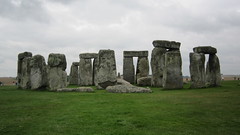
|
Stonehege, England (2500 BCE) Made of earthworks/stones + Circlesin ground surround the stone 3 circles... 1st– earth circle with mounds 2nd– inner circle with small stones 3rd– stone trilithons (Trilithons – two large vertical stones(posts)) supporting a third stone set (lintel) set horizontally over the twoo Postand lintel also known as a post and beam system· Mortise and tenon joints used in theconstruction (Typicallyused in wood construction) |
|
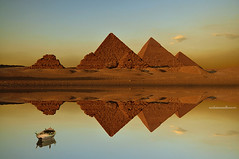
|
Pyramids Complex, Giza, Egypt, ca.2500 BCE -Pyramids are solid, no interior space, entranceto the tomb is part way up the side -Tomb entrance was originally Hiddento deter grave robbers -Use ramps to carry stones up the pyramido Requiredmany years -Largest pyramid, known as the Great Pyramid 100,000 workers on the structure for 3 months a year during the Nile’s annualflood§ Impossible to farm the land and populationunemployed so the pharaoh provided work, food and clothing -Constructedwith limestone -Sidesare oriented to the four cardinal points of the compass· Mastaba – bench-shaped tomb form Stackedon top of each other to form step pyramid,Evolvedinto the smooth sided pyramid known today -Flat landscape, pyramids tower over the landscape -Tallest one nearly 500 ft. |
|
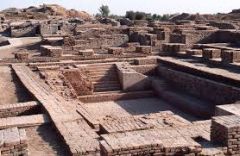
|
Mohenjo Daru, Indus Valley, Pakistan, ca.2400-2000 BCE -Walled city built on a grid, large city blocks,subject to floods from the Indus river ·People accessed their homes from above andentered via a ladder (protected from invaders) -Advanced engineering systems for controllingwater all across the city· ---Made entirely of sun-baked brick -Bitumenused as the “mortar”· Included palaces, baths, granaries -Thecivilization was supported from the grain grown in the river valley· Designed as a gridded city· The city was weakened by floods and subsequentlyattacked and destroyed |
|

|
City plan, Chang'an, China, 6th century CE -Ancient Han Capitol oriented in cardinal direction -Eastern end of the Silk Road -Reflected the orderly principles of Chinese -Highlights importance of imperial palace/emperor -Grid allowed soldiers to patrol easy -Roadways contain drainage system -Alleys between building opened/closed to help police -Front to back... less important to more important buildings in back -Taoist and Buddhist monasteries where everywhere in the city |
|
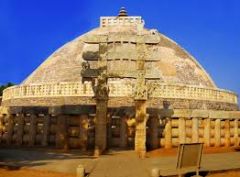
|
Great Stupa and Monastery, Sanchi, India, ca.250 BCE-250 CE -Mandala-sspiritual and ritual symbol of Hinduism/Buhdism (Universe) -Part of large complex, stupa serves as a reliquary, holds artifacts -Multiple materials used in construction (gate=stone,walk area=fired brick, Stupa=mud brick) -Buddhist monks live in viharas (monasteries) scattered around -Ashaka the Great ordered the stupa to be built Four gateways alligned in Cardinal Directions Meant to be walked around in contemplation |
|

|
Pantheon, Rome, Italy, 125 CE -Commissioned by Marcus Agrippa (RomanStatesman and architect) -Built as a temple to all Roman Gods, Pantheonmeans “all Gods” -Radically new and different building -Held traditional elementsFrontal porch Porticois the frontal colonnade porch Corinthian columns -New elements…Oculus was a hole in the center ofthe roof, Coffers are the indents inside the dome (Helped to lighten the loadof the roof on the building) -Exemplified Roman civilization -Height of the dome is equal to the width of thecella -Vast interior space of the temple made itunusual -Later became a Christian church -Rich interior ornamented with marbles fromaround the empire -Built using concrete poured over framing -Dome varies in thickness from 21 feet at thebase to 4 feet at the top -Step rings were used to support the outwardforce of the Pantheon and redirect it downward |
|
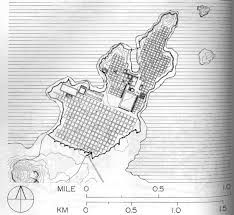
|
City plan, Miletus, Turkey, rebuilt after 479 BCE -Greek colony -Grid form designed by the Greek city planner Hippodamus(Hippodamus is known as the father of urban planning -Alexander the Great and the Romans adapted how he designed cities -Designatedstandard size for city blocks,Allocated public/private space -Reserved the acropolis(highest place) for the cities most important temples - Theater of Miletus designed Hippodamus as wellAgora with bouleterion - Agora – “gatheringplace” center of athletic, artistic, spiritual and political lifeBouleterion – council house |
|

|
City plan, Timgad, Algeria, ca.100 CE -Roman colony, founded by emperor Trajan asmilitary colony -Gridded city plan system -Colonnade lines the main streets of the city -Illustrates Roman urban planning at it’s height (Mimickedthe ideas of Hippodamus with gathering buildings in middle) -Constructed entirely of stone -Streets paved with large rectangularlimestone slabs -14 baths, demonstrates the attention towardspublic buildings -Houses had mosaics to offset the absence ofmarble in the construction of the city -Square enclosure and orthogonal design based oncardo and decumanus the two perpendicular routes running through the city -City itself used to show the grandeur of Rome onNumidian soil -City spread to the west and the South beyond theramparts -Library, demonstrates presence of fullydeveloped system shows culture |
|

|
Great Wall, China (221 BCE- 17th century CE) -Initially independent fortifications united intoone continuous wall by Qin Shi Huangdi -Largely rebuilt during the 14th-17thcenturies during the Ming Dynasty -Defensive wall to protect against the Mongolsfrom the North· Before the use of bricks, the wall was mainlybuilt from earth, stone and wood -Series of beacon and watch towers -Varies in height along the wall, tallest inflat, militarily important locations, shorter while passing over the steepmountains -Used local materials in the construction of thewall -Laborers included soldiers, forcibly recruitedpeasants, convicts and war prisoners -Bodies of workers that died were put into the wall -Symbol of Chinese strength |
|
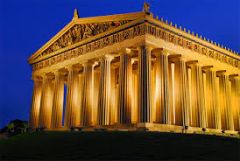
|
Parthenon and Acropolis, Athens,Greece, 448-432 BCE -Most famous exampleof Doric columns -Acropolis (definition) – highest point in the cityAcropolis had multiple buildings on it, the most famousbeing the ParthenonParthenon was a symbol democracy and Greek civilization -Dedicated to Athena Parthenos the goddess of the city ofAthens (Built under the instruction of Pericles) -The cella (inner chamber) was large to accommodate theoversized statue of Athena -The middle of the Doric columns bulged to represent life andthe burden of the weight of the Parthenon as well as an optical illusion tomake them appear straight (entasis) -Frieze is the marble sculpture that adorned theupper part of the cella or naos -Pedement is the upper triangular part needed to makethe roof sloped--Very precise construction, scaled the columns down tofigure out exact diameters of each slab |
|
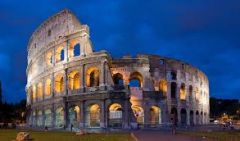
|
Colosseum (Flavian Amphitheater), Rome, Italy, 80 CE -Built by the Flavian family -Housed the gladiator games -Completely manmade oval amphitheater -Underground level -4 tiers of seats with service areas below -The arena floor was wooden -Name comes from the Colossus of Nero (statue ofemperor) -Barrel vaults (Seriesof individual arches that ran across and around the colosseum) -Start of using concrete -Distinctive elements: (Outerfaçade engaged columns embellished building -Differentcolumn orders at each level-Doriclowest, Ionic, Corinthian, Corinthian pilasters -First amphitheater to have rooms underneath the seats -35,000 people could sit in it |
|

|
St. John Lateran, Rome, Italy, 313 CE -Located outside the city due to the politicalopposition from the Pagan aristocracy -Constructed in the shape of the cross (Shows that it is free from Paganassociation) -Most major of the basilicas of Rome -Adjacent to the boundaries of the Vatican city -First early Christian church -Post and lintel construction with a truss roof -Utilized the longitudinal (basilica) plan -Ordered by the first Christian Emperor,Constantine -Seat of the Bishop of Rome (Pope) |
|

|
Hagia Sophia, Istanbul, Turkey, 532-37, -Justinian’s great church -Minaret towers surrounding it, later added whenit was converted to a Muslim church -Combined longitudinal and centralized churchplans -Pendentive (curved triangle thing) helps toredirect the outward force down -Gold mosaics and marble on the interior -Enter through the atrium to the interior of thechurch -Lots of windows -Brick layers use more mortar than brick whichactually weaken the wall |
|
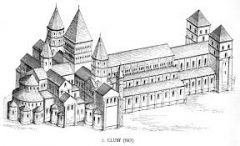
|
Monastery and Church, Cluny, France, 11th century -5 aisled church -Elaborate apse with radiating chapels -Although it was a Romanesque church it utilizedfired brick instead of stone or marble -Utilized the longitudinal plan -Built in the Romanesque style which utilizedsemicircular arches -One of the spots on a pilgrimage trip -Almost entirely destroyed during the Frenchrevolution -Charlemagne was Emperor at the time it was built -Choir which was seating for the clergy and thechoir |
|
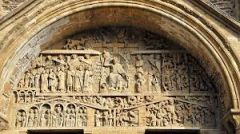
|
St. Foy, Conques, France, ca.1050-1130 -Tympanum – triangular or semi-circular decorativewall surface over an entrance, contains sculpture or other elements -On a pilgrimage route to Santiago de Compostela -Chavet is the small chapel connected to the mainchapel -Two towers in the front of the chapel make up thewestwerk -Made of fired brick -Rib vault (Vault where ribs ride below andusually support the vault web) -Utilizes the longitudinal plan |
|
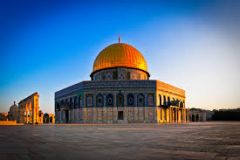
|
Dome of the Rock, Jerusalem, 691 -Detailed mosaics -Fired brick, masonry construction-Qibla is the direction that Muslims should prayso that they face Mecca ....Islamic places of worship are oriented towards Mecca ....Amihrab is a semi-circular niche in the wall that indicates the direction topray ...Minbaris a pulpit in the mosque where the prayer leader delivers sermons -Ablution fountain – where Muslims wash beforeprayer-Sahn is the outer courtyard area of the dome-Minaret – tall slender tower part of the mosquefrom where a muezzin (priest) calls Muslims to prayer (means entrance) -Muqarnas – form of architectural ornamentalvaulting which results in the geometric subdivision leading to a sort of cellular structure -Surrounds the holy rock where Muhammad ascended to heaven |
|
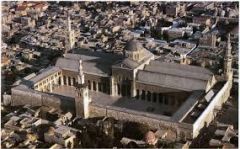
|
Great Mosque, Damascus, Syria, 706-715 -Ablution fountain – where Muslims wash beforeprayer -Sahn is the outer courtyard area of the dome -Minaret – tall slender tower part of the mosquefrom where a muezzin (priest) calls Muslims to prayer (means entrance) -Muqarnas – form of architectural ornamentalvaulting which results in the geometric subdivision leading to a sort ofcellular structure-Surrounds the holy rock where Muhammad ascendedto heaven |
|
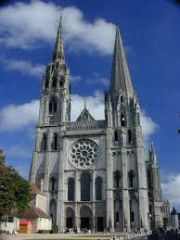
|
Notre-Dame Cathedral, Chartres, France, 1194-1250 -Flying buttresses made up the external skeletonof the cathedral and supported the high vertical walls -Tracery is ornamental stone divisions used onthe windows -Utilized pointed arches -Gothic architecture ...Pointedarches ...Stainedglass ...Flyingbuttresses ...Ribvaults -Masonry construction and fired brick |

